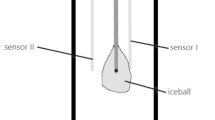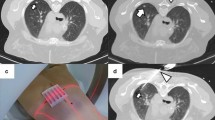Abstract
To evaluate the efficacy of radiofrequency lung ablation with transbronchial saline injection. The bilateral lungs of eight living swine were used. A 13-gauge bone biopsy needle was inserted percutaneously into the lung, and 1 ml of muscle paste was injected to create a tumor mimic. In total, 21 nodules were ablated. In the saline injection group (group A), radiofrequency ablation (RFA) was performed for 11 nodules after transbronchial saline injection under balloon occlusion with a 2-cm active single internally cooled electrode. In the control group (group B), conventional RFA was performed for 10 nodules as a control. The infused saline liquid showed a wedge-shaped and homogeneous distribution surrounding a tumor mimic. All 21 RFAs were successfully completed. The total ablation time was significantly longer (13.4 ± 2.8 min vs. 8.9 ± 3.5 min; P = 0.0061) and the tissue impedance was significantly lower in group A compared with group B (73.1 ± 8.8 Ω vs. 100.6 ± 16.6 Ω; P = 0.0002). The temperature of the ablated area was not significantly different (69.4 ± 9.1°C vs. 66.0 ± 7.9°C; P = 0.4038). There was no significant difference of tumor mimic volume (769 ± 343 mm3 vs. 625 ± 191 mm3; P = 0.2783). The volume of the coagulated area was significantly larger in group A than in group B (3886 ± 1247 mm3 vs. 2375 ± 1395 mm3; P = 0.0221). Percutaneous radiofrequency lung ablation combined with transbronchial saline injection can create an extended area of ablation.




Similar content being viewed by others
References
Goldberg SN, Gazelle GS, Compton CC et al (1996) Radiofrequency tissue ablation of VX2 tumor nodules in the rabbit lung. Acad Radiol 3:929–935
Miao Y, Ni Y, Bosmans H et al (2001) Radiofrequency ablation for eradication of pulmonary tumor in rabbits. J Surg Res 99:265–271
Yan TD, King J, Sjarif A et al (2006) Percutaneous radiofrequency ablation of pulmonary metastases from colorectal carcinoma: prognostic determinants for survival. Ann Surg Oncol 13:1529–1537
Ambrogi MC, Lucchi M, Dini P et al (2006) Percutaneous radiofrequency ablation of lung tumors: results in the mid-term. Eur J Cardiothoracic Surg 30:177–183
Steinke K, Sewell PE, Dupuy D et al (2004) Pulmonary radiofrequency ablation: an international study survey. Anticancer Res 24:339–343
Steinke K, Glenn D, King J et al (2003) Percutaneous pulmonary radiofrequency ablation: difficulty achieving complete ablation in big lung lesions. Br J Radiol 76:742–745
Goldberg SN, Gazelle GS, Dawson SL et al (1995) Radio-frequency tissue ablation using multiprobe arrays: greater tissue destruction than multiple probes operating alone. Acad Radiol 2:670–674
Goldberg SN, Solbiati L, Hahn PF et al (1998) Large-volume tissue ablation with radio frequency by using a clustered, internally cooled electrode technique: laboratory and clinical experience in liver metastases. Radiology 209:371–379
Lee JM, Youk JH, Kim YK et al (2003) Radio-frequency thermal ablation with hypertonic saline solution injection of the lung: ex vivo and in vivo feasibility studies. Eur Radiol 13:2540–2547
Lee JM, Kim SW, Li CA et al (2002) Saline-enhanced radiofrequency thermal ablation of the lung: a feasibility study in rabbits. Korean J Radiol 3:245–253
Gananadha S, Morris DL (2004) Saline infusion markedly reduces impedance and improves efficacy of pulmonary radiofrequency ablation. Cardiovasc Intervent Radiol 27:361–365
Miao Y, Ni Y, Yu J et al (2000) A comparative study on validation of a novel cooled–wet electrode for radiofrequency liver ablation. Invest Radiol 35:438–444
Lee JM, Han JK, Kim SH et al (2004) Comparison of wet radiofrequency ablation with dry radiofrequency ablation and radiofrequency ablation using hypertonic saline preinjection: ex vivo bovine liver. Korean J Radiol 5:258–265
Lubienski A, Dux M, Lubienski K et al (2005) Radiofrequency thermal ablation: increase in lesion diameter with continuous acetic acid infusion. Cardiovasc Intervent Radiol 28:789–794
Oshima F, Yamakado K, Akeboshi M et al (2004) Lung radiofrequency ablation with and without bronchial occlusion: experimental study in porcine lungs. J Vasc Interv Radiol 15:1451–1456
Anai H, Uchida BT, Pavcnik D et al (2006) Effects of blood flow and/or ventilation restriction on radiofrequency coagulation size in the lung: an experimental study in swine. Cardiovasc Intervent Radiol 29:838–845
Kawai T, Kaminou T, Sugiura K et al (2009) Creation of a tumor-mimic model using a muscle paste for radiofrequency ablation of the lung. Cardiovasc Intervent Radiol 32:296–302
Steinke K, Haghighi KS, Wulf S et al (2005) Effect of vessel diameter on the creation of ovine lung radiofrequency lesions in vivo: preliminary results. J Surg Res 124:85–91
Oyama Y, Nakamura K, Matsuoka T et al (2005) Radiofrequency ablated lesion in the normal porcine lung: long-term follow-up with MRI and pathology. Cardiovasc Intervent Radiol 28:346–353
Dixon CM (1995) Transurethral needle ablation for the treatment of benign prostatic hyperplasia. Urol Clin North Am 22:441–444
Johansen B, Melsom MN, Flatebo T et al (1998) Time course and pattern of pulmonary flow distribution following unilateral airway occlusion in sheep. Clin Sci 94:453–460
Isawa T, Benfield JR, Johnson DE et al (1971) Pulmonary perfusion changes after experimental unilateral bronchial occlusion and their clinical implications. Radiology 99:355–360
Author information
Authors and Affiliations
Corresponding author
Rights and permissions
About this article
Cite this article
Kawai, T., Kaminou, T., Sugiura, K. et al. Percutaneous Radiofrequency Lung Ablation Combined with Transbronchial Saline Injection: An Experimental Study in Swine. Cardiovasc Intervent Radiol 33, 143–149 (2010). https://doi.org/10.1007/s00270-009-9769-2
Received:
Accepted:
Published:
Issue Date:
DOI: https://doi.org/10.1007/s00270-009-9769-2




